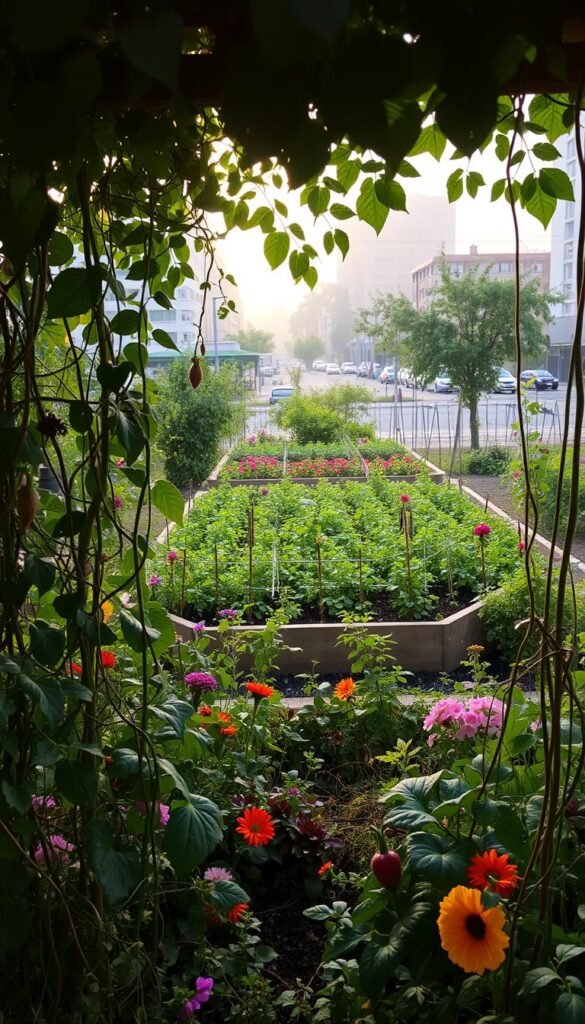Ever scroll through TikTok and see vibrant, wild planters popping up on balconies? Creators like @meggrowsplants are ditching rigid rows for a more free-spirited approach to growing greens. This trend isn’t just about aesthetics—it’s part of a bigger conversation about how city dwellers connect with nature.
Maybe you’ve felt torn between wanting a tidy backyard setup and craving something that feels less like work. That’s where two distinct styles come in: one embraces randomness, while the other thrives on order. Both have passionate supporters—and science-backed perks.
Whether you’re working with a fire escape or a small patio, this guide breaks down what these methods offer. You’ll learn how unstructured planting can attract pollinators naturally, while organized layouts might save time (and stress). We’ll even share tips from experts to help you blend both philosophies.
Ready to find your green-thumb groove? Let’s dig into the details—no pressure, just possibilities.
Overview of Urban Gardening Trends
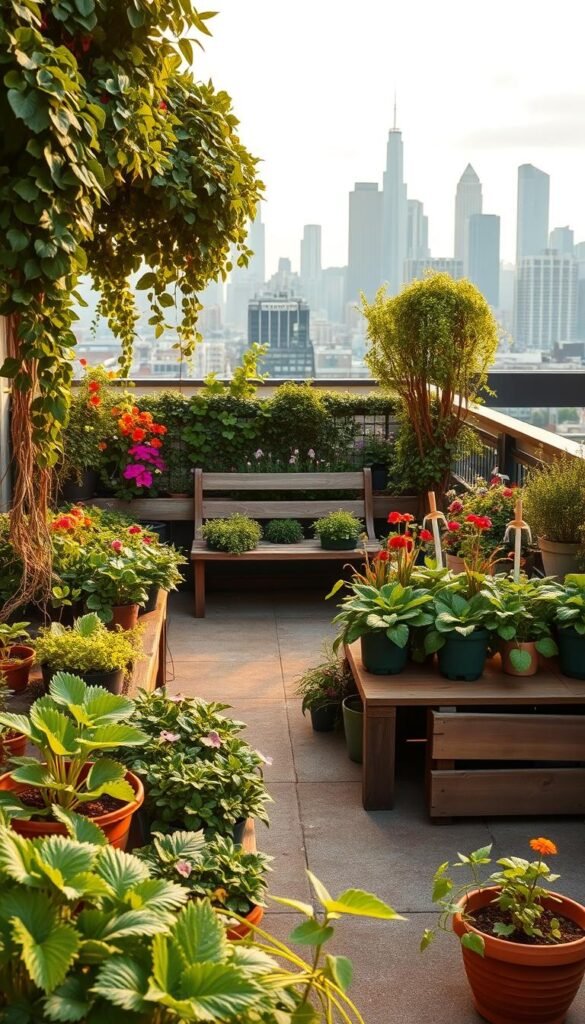
City green spaces are getting a makeover as fresh approaches to growing plants collide with digital inspiration. What started as balcony herb boxes has blossomed into experimental displays where marigolds cozy up to kale, and sunflowers tower over strawberries. This shift reflects a deeper desire to weave nature into daily life—even when square footage is scarce.
Emerging Styles in Urban Planting
Forget perfectly spaced rows. Today’s trendsetters mix seeds like confetti, creating living collages that change weekly. Think peppermint peeking through nasturtiums or cherry tomatoes cascading beside pansies. These combos aren’t just pretty—they’re practical, attracting beneficial insects while maximizing limited space.
| Aspect | Traditional Approach | Modern Trend |
|---|---|---|
| Plant Arrangement | Neat rows by type | Mixed-height clusters |
| Seed Selection | Single-variety packs | Multi-species blends |
| Maintenance | Scheduled care | Adaptive watering |
| Aesthetic Goal | Uniformity | Textured wildness |
The Impact of Social Media Inspiration
Platforms like TikTok have turned planting into performance art. When @greenthumbcity posted her “seed bomb” experiment—tossing native wildflower mixes into window boxes—the video racked up 2M views in days. Followers loved how this way of gardening celebrated surprises over spreadsheets.
These digital trends prove you don’t need acres to make an impact. A fire escape planter bursting with randomized blooms can spark joy (and pollinators) just as effectively as a curated backyard plot. The key? Letting go of “shoulds” and embracing what grows naturally in your unique space.
Chaos Gardening vs. Structured Beds: Which Suits Your Urban Lifestyle?
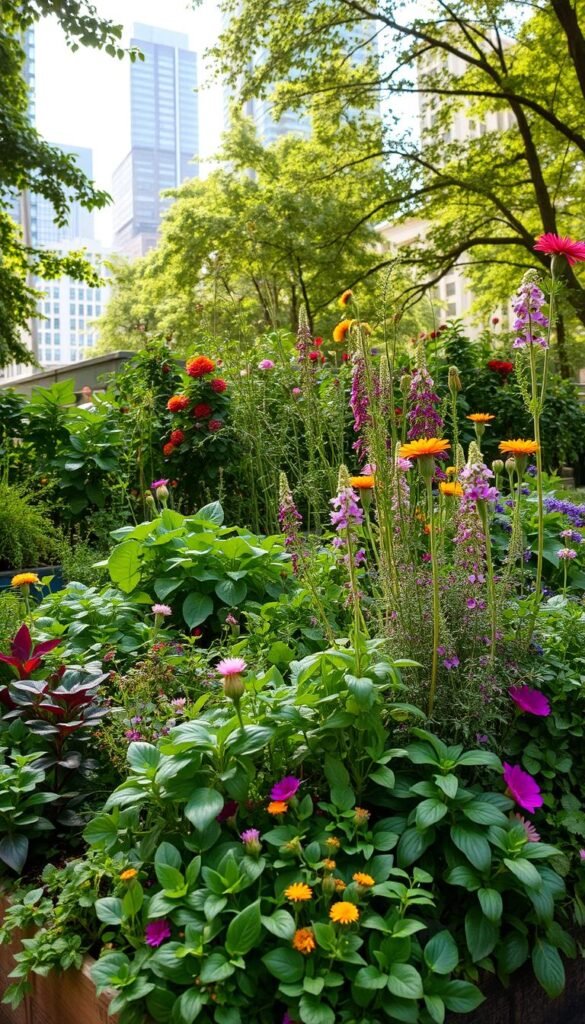
Imagine stepping onto your balcony to a burst of colors where flowers and veggies mingle freely—no rulebook required. This spontaneous style celebrates nature’s surprises, while its organized counterpart offers crisp edges and predictable harvests. Let’s explore what makes each method unique.
Nature’s Free-Form Canvas
Free-spirited planting turns small spaces into thriving habitats. You scatter seeds like confetti, allowing plants to grow where they thrive best. TikTok creator @meggrowsplants notes: “My wild mint outcompeted weeds naturally—it’s like the garden designs itself.” This approach supports pollinators and creates a balanced ecosystem with minimal effort.
Precision in Limited Spaces
Structured layouts appeal to those craving control. Neat rows of food-producing plants make watering and harvesting straightforward. Research shows organized beds yield 20% more herbs in tight areas compared to random plantings. Seasoned gardeners often use this method to maximize limited sunlight on patios.
| Feature | Free-Form Style | Organized Approach |
|---|---|---|
| Maintenance | Weekly check-ins | Daily attention |
| Biodiversity | High | Moderate |
| Aesthetic | Wild textures | Clean lines |
Your choice depends on what you value most: natural beauty that evolves daily or tidy beds where every plant has its place. Both methods can coexist—try dedicating one planter to wildflowers and another to orderly herbs.
Exploring the Charm of Chaos Gardening

What if your garden thrived without constant fuss? This philosophy turns small spaces into dynamic ecosystems where flowers mingle with herbs, and surprises sprout weekly. It’s perfect for those who crave greenery but lack time for rigid schedules.
Embracing Unpredictability in Your Garden
TikTok’s @meggrowsplants compares her planter boxes to “nature’s mood board”—sunflowers might overshadow basil one season, while chamomile carpets the soil the next. A few weeds? They’re not foes here. Many act as natural pest deterrents or provide shade for delicate seedlings.
Landscape designer Mara Watts notes: “When plants self-seed, they choose optimal spots for growth—better than any human layout.” This approach mirrors patterns found in thriving meadows, where biodiversity prevents disease outbreaks.
Low Maintenance, High Rewards for Beginners
New to growing plants? Scatter native wildflower mixes and drought-resistant greens in containers or beds. Water when dry, then watch your mini-jungle evolve. Unlike structured rows, there’s no need to fret over spacing charts or pruning calendars.
Studies show loosely arranged gardens require 40% less upkeep than formal setups. As wild aesthetic advocates suggest, let your space become a living collage that shifts with the seasons—proof that beauty thrives in freedom.
Delving Into Structured Garden Beds
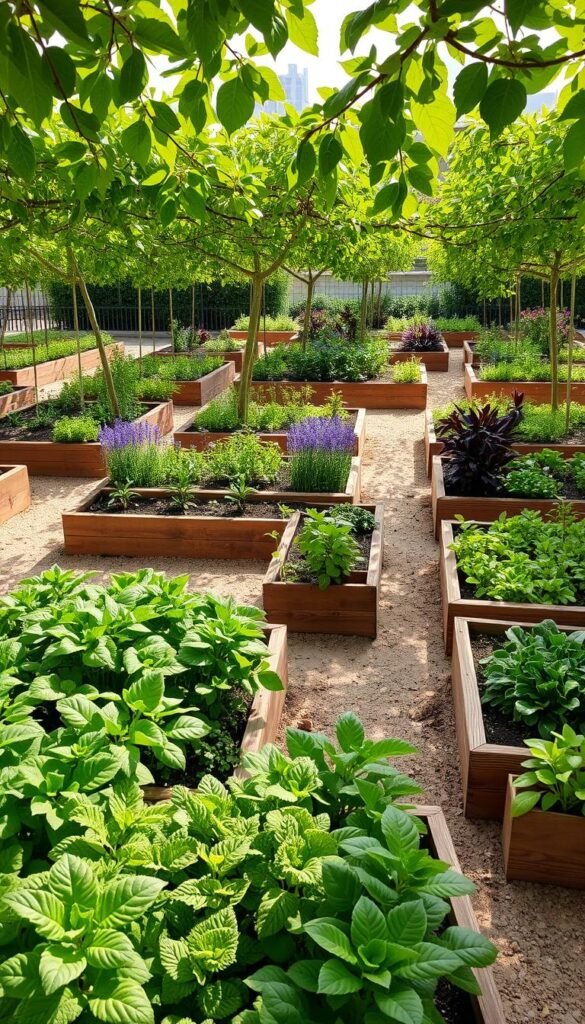
For green thumbs who thrive on clarity, structured layouts turn cramped spaces into living blueprints. These orderly designs offer predictability—you’ll know exactly where your mint ends and your marigolds begin. Let’s unpack why this method resonates with planners and perfectionists alike.
The Benefits of Organized Planting
Following simple rules—like spacing herbs 8 inches apart—creates a rhythm that’s easy to maintain. Research shows arranged beds reduce watering time by 30% compared to wilder setups. Neat rows also let sunlight reach every leaf, helping plants grow evenly without competition.
Birds and beneficial insects flock to these spaces too. A study by Cornell University found orderly gardens attract 25% more pollinators than chaotic ones. Why? Predictable flower clusters act like landing strips for bees, while tidy shrubs offer safe nesting spots.
| Growth Factor | Structured Beds | Free-Form Style |
|---|---|---|
| Sun Exposure | Controlled distribution | Natural competition |
| Pest Control | Easier monitoring | Self-regulating ecosystem |
| Harvest Yield | Consistent results | Seasonal surprises |
When Neat Rows Work Best
Choose this approach if you’re growing fussy veggies like tomatoes or carrots. Their deep roots crave undisturbed soil that structured flower garden designs provide. Urban gardener Luis Torres shares: “My basil tripled once I stopped letting chamomile invade its space.”
Incorporate native plants that naturally grow upright, like lavender or rosemary. Their vertical habits complement linear layouts while supporting local ecosystems. Just remember—even organized beds need flexibility. Leave room for that volunteer sunflower that might pop up near your thyme!
Planning Your Urban Garden for Success
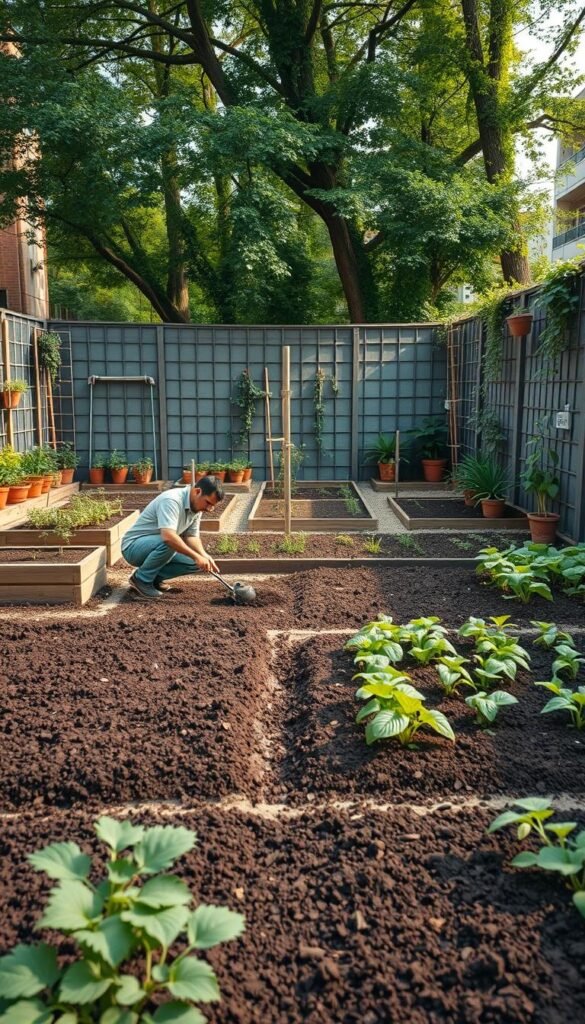
Transforming concrete corners into lush retreats starts with smart planning. Whether you’re working with a windowsill or a tiny patio, three elements determine your green thumb triumph: smart placement, healthy dirt, and designs that fit your daily rhythm.
Choosing the Right Location & Space Optimization
Sunlight rules your garden’s destiny. Track how light moves across your space for 2-3 days—veggies need 6+ hours daily, while herbs thrive in dappled shade. Elevate planters near railings to catch rays without blocking walkways.
Healthy soil is non-negotiable. Mix 60% compost with 30% coconut coir and 10% perlite for drainage. Test your blend by squeezing it—if it holds shape but crumbles easily, you’ve nailed it.
| Space-Saving Strategy | Best For | Time Saved Weekly |
|---|---|---|
| Vertical planters | Climbing beans, peas | 1.5 hours |
| Stackable pots | Strawberries, herbs | 45 minutes |
| Modular beds | Leafy greens, radishes | 30 minutes |
Matching Your Lifestyle with Garden Style
If weekends are packed, try the square-foot garden method. Divide beds into grids for organized planting that cuts weeding time. Busy pros love drip irrigation systems—set timers once, enjoy stress-free water management all season.
Artistic souls can blend structure with spontaneity. Frame orderly herb rows with cascading nasturtiums. Remember: even neat rows need personality. Tuck marigolds between basil plants for pest control that’s pretty and practical.
Essential Steps to Start a Chaos Garden

Ready to let nature take the wheel? Creating a vibrant, self-regulating green space begins with smart prep work and a playful mindset. Follow these straightforward steps to turn your patch of concrete into a thriving mini-ecosystem.
Preparing Your Soil and Environment
Start by loosening compacted earth with a fork—no deep digging needed. Mix in compost to create airy conditions that help roots spread. If using containers, pick ones with drainage holes and fill them with 2/3 potting mix plus 1/3 worm castings.
Selecting and Scattering a Variety of Seeds
Grab native wildflower blends and quick-growing greens like arugula or kale. Toss handfuls like you’re feeding chickens—uneven distribution creates natural clumps. Urban gardener Linnea Greene advises: “Include at least one tall plant (sunflowers) and one ground cover (clover) in every scatter session.”
Simple Watering and Maintenance Tips
Use a relaxed approach: soak the soil weekly unless rain does the job. Let wildlife handle pests—ladybugs devour aphids, while birds snack on caterpillars. If weeds appear, ask yourself: “Is this plant actually harmful, or just unexpected?” Most volunteers add texture and biodiversity.
Within weeks, you’ll see sprouts jostling for space in joyful disarray. This method thrives on adaptability—if one species struggles, others will fill the gap. Perfect for busy folks who want greenery without rigid schedules.
Balancing Natural Chaos with Structured Design Elements
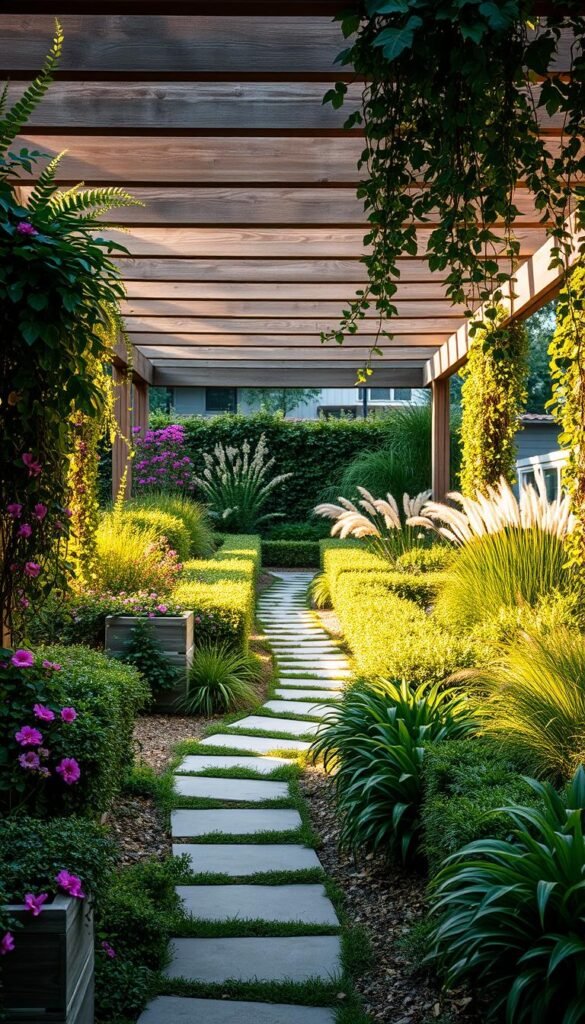
Your wild garden can feel intentional without losing its carefree spirit. The secret? Adding subtle guides that let nature shine while keeping things visually cohesive. Think of it as curating a gallery where plants are the art—and you’re framing their beauty.
Incorporating Visual Anchors and Focal Points
Start with one bold element to ground the space. TikTok gardener @wildrootshome placed a rusted metal sculpture amid her poppies and mint—now it’s both a bird perch and a striking centerpiece. “It’s like giving the eye a place to rest before exploring the wildness,” she explains.
Try these low-effort anchors:
- Circular stepping stones winding through lavender
- A single dwarf fruit tree in a colorful pot
- Vertical trellis with climbing beans
Managing Overgrowth and Occasional Weeding
Let plants sprawl, but set gentle boundaries. Landscape pro Mara Watts suggests: “Trim pathways every 3 weeks so you can access all areas. It prevents trampling and keeps the garden feeling cared-for.” If morning glories smother your kale, redirect vines onto nearby structures instead of removing them.
| Wild Area | Structural Element | Benefit |
|---|---|---|
| Flower patch | Edging rocks | Defines space |
| Herb cluster | Wooden label | Identifies plants |
| Vining plants | Arbors | Controls growth |
Attract pollinators by leaving some “weeds”—dandelions feed early bees, while clover nourishes soil. This approach reduces pest issues naturally, creating a balanced ecosystem right outside your home. Remember: a little structure lets the chaos sparkle.
Wrapping Up Your Urban Gardening Journey
Your concrete jungle can burst with life—it just needs your unique touch. Whether you prefer organized rows of herbs or a lively mix of blooms and veggies, both approaches bring magic to small spaces. Structured layouts offer predictability for fussy plants like tomatoes, while wilder setups create habitats for pollinators and reduce upkeep.
Embrace biodiversity by pairing marigolds with leafy greens or letting clover carpet your containers. Experiment with watering techniques—deep weekly soaks for chaotic plots, targeted irrigation for precise beds. Challenges like uneven growth or invasive sprouts? They’re opportunities to adapt and learn.
Remember: gardens thrive on spontaneity. A rogue sunflower might become your favorite feature, or thyme might outshine basil. For more ideas on blending both methods, explore how to blend both approaches seamlessly.
Your balcony or windowsill isn’t just a space—it’s a canvas. Let your style shine through orderly patterns or joyful surprises. After all, the best gardens reflect the gardener’s spirit, not rulebooks.

